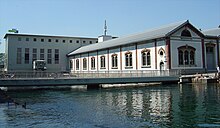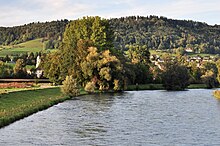| Limmat | |
|---|---|
 The Limmat in Zürich, looking downstream to Rathausbrücke from Quaibrücke at Lake Zurich, Stadthausquai to the left and Limmatquai to right. The Limmat in Zürich, looking downstream to Rathausbrücke from Quaibrücke at Lake Zurich, Stadthausquai to the left and Limmatquai to right. | |
 | |
| Location | |
| Country | Switzerland |
| Cantons | Zürich, Aargau |
| Settlements | Zürich (ZH), Schlieren (ZH), Dietikon (ZH), Oetwil a.d.L. (ZH), Wettingen (AG), Baden (AG), Ennetbaden (AG), Nussbaumen (AG), Turgi (AG), Untersiggenthal (AG) |
| Physical characteristics | |
| Source | |
| • location | Lake Zurich, Zürich |
| • coordinates | 47°22′00″N 8°32′35″E / 47.36677°N 8.54316°E / 47.36677; 8.54316 |
| • elevation | 406 m (1,332 ft) |
| Mouth | |
| • location | Aare, Gebenstorf |
| • coordinates | 47°30′07″N 8°14′15″E / 47.5019°N 8.2375°E / 47.5019; 8.2375 |
| • elevation | 328 m (1,076 ft) |
| Length | 36.3 kilometres (22.6 mi), 140 kilometres (87 mi) (Lake Zurich and Linth included) |
| Basin size | 2,416 km (933 sq mi) (Lake Zurich and Linth included) |
| Discharge | |
| • location | Baden |
| • average | 101.0 m/s (3,570 cu ft/s) (MQ 1951-2013) |
| • minimum | 69.2 m/s (2,440 cu ft/s) (MNQ 1951-2013), 24.6 m/s (870 cu ft/s) (NNQ, 2003) |
| • maximum | 141 m/s (5,000 cu ft/s) (MHQ 1951-2013), 657 m/s (23,200 cu ft/s) (HHQ, 1999) |
| Basin features | |
| Progression | Aare→ Rhine→ North Sea |
| Tributaries | |
| • left | Sihl, Schäflibach, Reppisch, Dorfbach Spreitenbach |
| • right | Länggenbach, Furtbach, Lugibach, Gottesgraben |
| Waterbodies | Lake Zurich, Stausee Wettingen |






The Limmat is a river in Switzerland. The river commences at the outfall of Lake Zurich, in the southern part of the city of Zürich. From Zürich it flows in a northwesterly direction, continuing a further 35 km until it reaches the river Aare. The confluence is located north of the small town of Brugg and shortly after the mouth of the Reuss.
The main towns along the Limmat Valley downstream of Zürich are Dietikon, Wettingen, and Baden. Its main tributaries are the Linth, Wägitaler Aa and Jona, all via Lake Zurich, the Sihl in Zürich, and the Reppisch in Dietikon.
The hydronym is first attested in the 8th century, as Lindimacus. It is of Gaulish origin, from *lindo- "lake" (Welsh llyn) and *magos "plain" (Welsh maes), and was thus presumably in origin the name of the plain formed by the Linth.
Power generation
Like many Swiss rivers, the Limmat is intensively used for production of hydroelectric power: along its course of 35 km (22 mi), its fall is used by no less than ten hydroelectric power stations. These include:
| This list is incomplete; you can help by adding missing items. (April 2013) |
Navigation
Historically, the Limmat was an important navigation route. In the twelfth and thirteenth centuries, voyages from Zürich to Koblenz are recorded. In 1447, the Emperor Frederick III granted the privilege of free navigation on the Limmat and on the Rhine to Zürich. Because of the current, navigation was typically downstream only, with the barges being sold on arrival.
Today, the Limmat is navigable for much of its length by small craft only, with many of the hydroelectric power plants incorporating boat lifts. The traditional boat type used on the river is the weidling, a flat-bottomed vessel that is usually 10 metres (33 ft) long.
The uppermost stretch of the river through the centre of Zürich is navigable by rather larger vessels, albeit limited by low bridges. On this stretch of the river the Zürichsee-Schifffahrtsgesellschaft (Lake Zurich Navigation Company) operates its Limmat boat service, from the Landesmuseum to Lake Zurich, using low-profile motor boats.
Towns near the river
- In the canton of Zürich:
- In the canton of Aargau
Cultural heritage
Located on the swamp land between Limmat and Lake Zurich around Sechseläutenplatz on small islands and peninsulas in Zürich, Prehistoric pile dwellings around Lake Zurich were set on piles to protect against occasional flooding by the Linth and Jona. Zürich–Enge Alpenquai is located on Lake Zurich lakeshore in Enge, a locality of the municipality of Zürich. It was neighbored by the settlements at Kleiner Hafner and Grosser Hafner on a then peninsula respectively island in the effluence of the Limmat, within an area of about 0.2 square kilometres (49.42 acres) in the city of Zürich. As well as being part of the 56 Swiss sites of the UNESCO World Heritage Site Prehistoric pile dwellings around the Alps, the settlement is also listed in the Swiss inventory of cultural property of national and regional significance as a Class object.
See also
References
- Felix Stähelin (1935), "Die vorrömische Schweiz im Lichte geschichtlicher Zeugnisse und sprachlicher Tatsachen", Zeitschrift für schweizerische Geschichte (in German), vol. Band 15, Leemann, pp. 337–368
- ^ "Limmat Power Generation". Regional Werke AG Baden. Archived from the original on 2013-05-21. Retrieved 2013-04-25.
- "Flusskraftwerk Dietikon". Elektrizitätswerke des Kantons Zürich. Archived from the original on 2013-05-22. Retrieved 2013-04-25.
- "Kraftwerk Höngg". City of Zürich. Archived from the original on 2013-06-28. Retrieved 2013-04-25.
- "Kraftwerk Letten". City of Zürich. Archived from the original on 2013-06-28. Retrieved 2013-04-25.
- "Kraftwerk Wettingen". City of Zürich. Archived from the original on 2013-01-15. Retrieved 2013-04-25.
- "Limmat". Historical Dictionary of Switzerland (in German). Retrieved 2013-04-24.
- "Funicular Boat Lifts of Switzerland". funimag.com. Retrieved 2013-04-24.
- "Clubportrait Schiffe" (in German). Archived from the original on 2005-12-15. Retrieved 2013-04-24.
- "Limmat river cruises". Zürichsee-Schifffahrtsgesellschaft. Retrieved 2013-04-24.
- "A-Objekte KGS-Inventar". Schweizerische Eidgenossenschaft, Amt für Bevölkerungsschutz. 2009. Archived from the original on 2010-06-28. Retrieved 2014-12-10.
- "Prehistoric Pile Dwellings in Switzerland". Swiss Coordination Group UNESCO Palafittes (palafittes.org). Archived from the original on 2014-10-07. Retrieved 2014-12-10.
- "World Heritage". palafittes.org. Archived from the original on 2014-12-09. Retrieved 2014-12-10.
External links
 Media related to Limmat at Wikimedia Commons
Media related to Limmat at Wikimedia Commons Media related to Limmat in Zürich at Wikimedia Commons
Media related to Limmat in Zürich at Wikimedia Commons- Limmat in German, French and Italian in the online Historical Dictionary of Switzerland.

